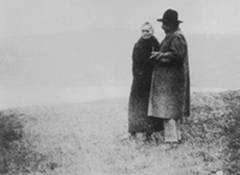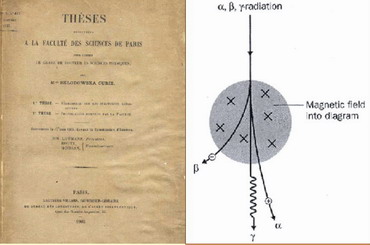Industrious PhD student
in age of 10 lost mother |
Well known picture - in every physics textbook is from her PhD thesis The examination committee expressed the opinion that the findings represented the greatest scientific contribution ever made in a doctoral thesis. Of the three members of the committee, two were to receive the Nobel Prize a few years later |
In 1903 with her husband was awarded with a Nobel prize in physics for: "a great contribution by common work to understanding phenomena discovered by Henry Becquerel" (who got it for "discovering spontaneous radioactivity"). In 1911 she was awarded with a Nobel prize in chemistry for: "a contribution in the field of chemistry by discovering chemical elements - polonium and radium, isolating ot them and the studies of chemical compounds of these extraordinary elements"
|

The Uranium ore, pitchblende, is a very complex mineral, made of combinations of up to 30 different elements. After grinding, dissolving, filtering, precipitating, collecting, re-dissolving, crystallising, re-crystallising 8 tonnes of pitchblende one can obtain 1 g of pure radium chloride.
Marie worked-out 1.5 tonne of pitchblende The relative atomic mass of radium Maria determined as 223.
Be careful: Her books are still radioactive to this very day.

Marie Curie Funding Opportunities Search Tool Host Fellowships/RTN
Use this search tool to find:
Vacancies and project information on Marie Curie Host Fellowship funded projects.
Vacancies and project information on Marie Curie Research Training Networks.
General Information on Marie Curie Actions can be found on the Marie Curie Web Site:
http://europa.eu.int/mariecurie-actions
for further information please e-mail RTD-MarieCurie-actions@cec.eu.int

In 1903 Marie and Pierre lost a child, born prematurely.
In 1906 Pierre was killed in a traffic accident. Marie refused an offer from the French Government for a pension. She claimed that she was young and strong enough to maintain herself and the children (nine-years-old Irène and 2-years-old Eve).
Irène and her husband, Frédéric Joliot-Curie, discovered artificial radioactivity and received the 1935 Nobel Prize for their discovery.
The younger daughter, married the American diplomat H. R. Labouisse. They have both taken lively interest in social problems, and as Director of the United Nations' Children's Fund he received on its behalf the Nobel Peace Prize in Oslo in 1965.
Life is not easy for any of us. But what of that? We must have perseverance and above all, confidence in ourselves. We must believe that we are gifted for something and that this thing must be attained.
![]()
 |
Marie Curie is, of all celebrated beings, the only one whom fame has not corrupted.Albert Einstein
|
